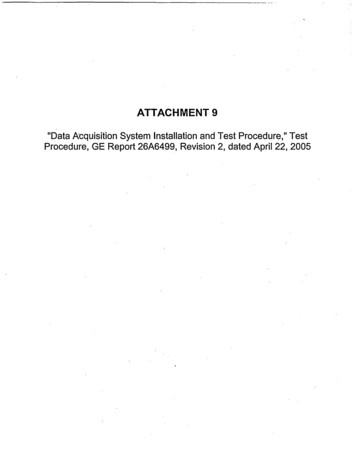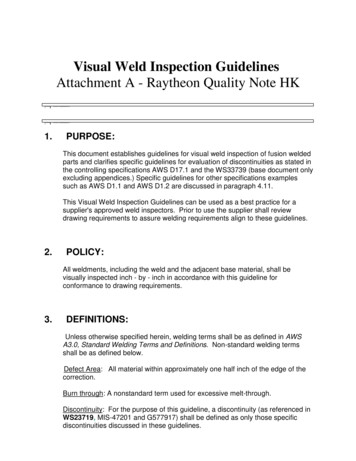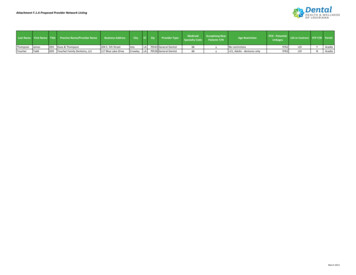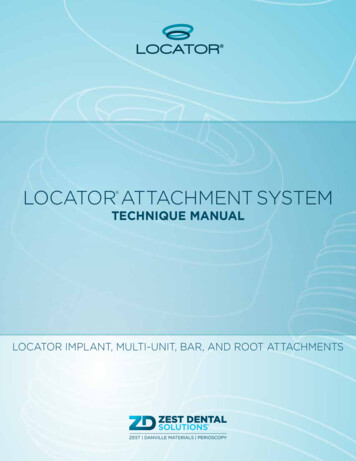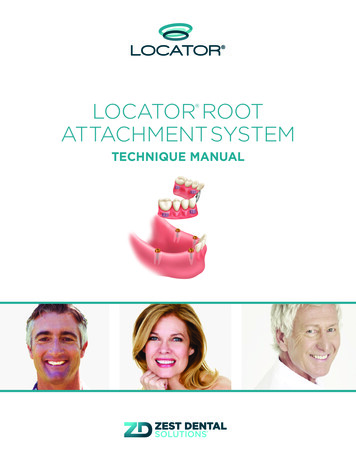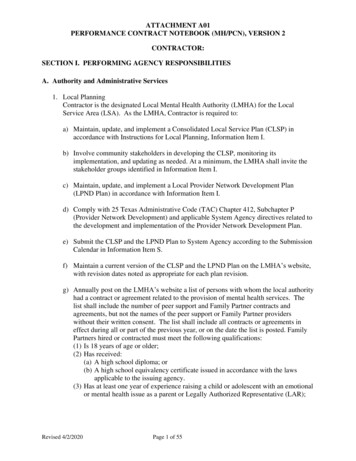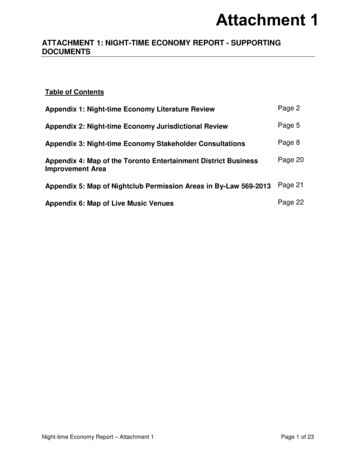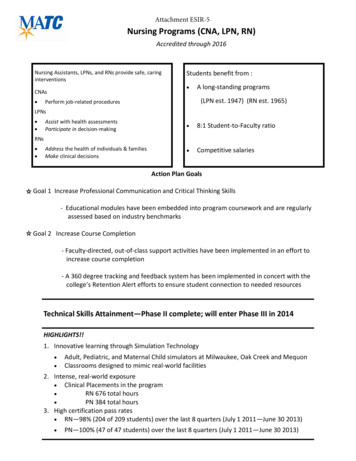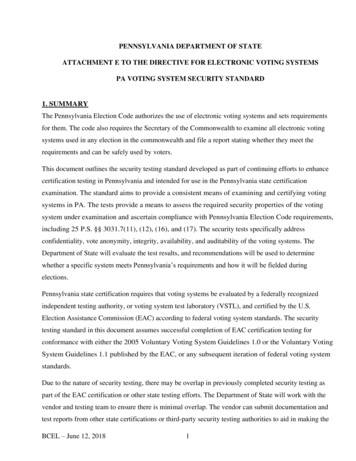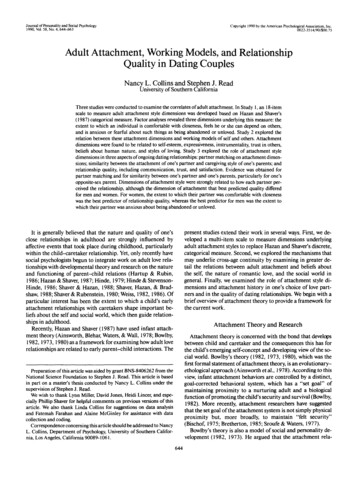
Transcription
Journal of Personality and Social Psychology1990, Vol. 58, No. 4, 644-663Copyright 1990 by the American Psychological Association, Inc0022-3514/90/S00.75Adult Attachment, Working Models, and RelationshipQuality in Dating CouplesNancy L. Collins and Stephen J. ReadUniversity of Southern CaliforniaThree studies were conducted to examine the correlates of adult attachment. In Study 1, an 18-itemscale to measure adult attachment style dimensions was developed based on Kazan and Shaver's(1987) categorical measure. Factor analyses revealed three dimensions underlying this measure: theextent to which an individual is comfortable with closeness, feels he or she can depend on others,and is anxious or fearful about such things as being abandoned or unloved. Study 2 explored therelation between these attachment dimensions and working models of self and others. Attachmentdimensions were found to be related to self-esteem, expressiveness, instrumentality, trust in others,beliefs about human nature, and styles of loving. Study 3 explored the role of attachment styledimensions in three aspects of ongoing dating relationships: partner matching on attachment dimensions; similarity between the attachment of one's partner and caregiving style of one's parents; andrelationship quality, including communication, trust, and satisfaction. Evidence was obtained forpartner matching and for similarity between one's partner and one's parents, particularly for one'sopposite-sex parent. Dimensions of attachment style were strongly related to how each partner perceived the relationship, although the dimension of attachment that best predicted quality differedfor men and women. For women, the extent to which their partner was comfortable with closenesswas the best predictor of relationship quality, whereas the best predictor for men was the extent towhich their partner was anxious about being abandoned or unloved.It is generally believed that the nature and quality of one'sclose relationships in adulthood are strongly influenced byaffective events that took place during childhood, particularlywithin the child-caretaker relationship. Yet, only recently havesocial psychologists begun to integrate work on adult love relationships with developmental theory and research on the natureand functioning of parent-child relations (Hartup & Rubin,1986; Kazan & Shaver, 1987;Hinde, 1979;Hinde&StevensonHinde, 1986; Shaver & Hazan, 1988; Shaver, Hazan, & Bradshaw, 1988; Shaver &Rubenstein, 1980; Weiss, 1982,1986). Ofparticular interest has been the extent to which a child's earlyattachment relationships with caretakers shape important beliefs about the self and social world, which then guide relationships in adulthood.Recently, Hazan and Shaver (1987) have used infant attachment theory (Ainsworth, Blehar, Waters, & Wall, 1978; Bowlby,1982,1973,1980) as a framework for examining how adult loverelationships are related to early parent-child interactions. Thepresent studies extend their work in several ways. First, we developed a multi-item scale to measure dimensions underlyingadult attachment styles to replace Hazan and Shaver's discrete,categorical measure. Second, we explored the mechanisms thatmay underlie cross-age continuity by examining in greater detail the relations between adult attachment and beliefs aboutthe self, the nature of romantic love, and the social world ingeneral. Finally, we examined the role of attachment style dimensions and attachment history in one's choice of love partners and in the quality of dating relationships. We begin with abrief overview of attachment theory to provide a framework forthe current work.Attachment Theory and ResearchAttachment theory is concerned with the bond that developsbetween child and caretaker and the consequences this has forthe child's emerging self-concept and developing view of the social world. Bowlby's theory (1982, 1973, 1980), which was thefirst formal statement of attachment theory, is an evolutionaryethological approach (Ainsworth et al., 1978). According to thisview, infant attachment behaviors are controlled by a distinct,goal-corrected behavioral system, which has a "set goal" ofmaintaining proximity to a nurturing adult and a biologicalfunction of promoting the child's security and survival (Bowlby,1982). More recently, attachment researchers have suggestedthat the set goal of the attachment system is not simply physicalproximity but, more broadly, to maintain "felt security"(Bischof, 1975;Bretherton, 1985; Sroufe& Waters, 1977).Bowlby's theory is also a model of social and personality development (1982, 1973). He argued that the attachment rela-Preparation of this article was aided by grant BNS-8406262 from theNational Science Foundation to Stephen J. Read. This article is basedin part on a master's thesis conducted by Nancy L. Collins under thesupervision of Stephen J. Read.We wish to thank Lynn Miller, David Jones, Heidi Lincer, and especially Phillip Shaver for helpful comments on previous versions of thisarticle. We also thank Linda Collins for suggestions on data analysisand Fatemah Farahan and Alaine McGinley for assistance with datacollection and coding.Correspondence concerning this article should be addressed to NancyL. Collins, Department of Psychology, University of Southern California, Los Angeles, California 90089-1061.644
ATTACHMENT, WORKING MODELS, AND RELATIONSHIP QUALITYtionship has a profound impact on the child's developing personality, and that the nature and quality of this early relationship is largely determined by the caregiver's emotionalavailability and responsiveness to the child's needs (Bowlby,1973). Through continued interaction, a child develops internal"working models" containing beliefs and expectations aboutwhether the caretaker is someone who is caring and responsive,and also whether the self is worthy of care and attention. Theseworking models are then carried forward into new relationships where they guide expectations, perception, and behavior(Bowlby, 1973). Thus, working models provide a mechanismfor cross-age continuity in attachment style and are of particular importance in understanding the role that early relationships have in determining adult relationships.An important addition to attachment theory was made byAinsworth et al. (1978), who explored individual differences inattachment relationships. From observations of infants andcaretakers, three distinct patterns or styles of attachment wereidentified: secure, anxious/avoidant, and anxious/ambivalent.And, consistent with Bowlby's theory, the three styles seemclosely associated with differences in caretaker warmth and responsiveness (Ainsworth et al., 1978; Egeland & Farber, 1984).These individual differences in attachment styles are thoughtto reflect differences in the psychological organization of theattachment system, a central part of which is the child's perception of whether the caretaker will be available and responsivewhen needed. Main, Kaplan, and Cassidy (1985) suggested thatindividual differences in attachment styles can be viewed as"differences in the mental representation of the self in relationto attachment [and] the secure versus various types of insecureattachment organizations can best be understood as terms referring to particular types of internal working models of relationships, models that direct not only feelings and behavior but alsoattention, memory, and cognition" (p. 67).Early Attachment and Later Social RelationsAttachment theory's emphasis on enduring cognitive modelsthat are carried forward into new relationships is consistentwith more general theories of personality (e.g., Epstein & Erskine, 1983; Sroufe & Fleeson, 1986) that view social, emotional, and personality development as inextricably linked toearly social relations. Empirical support for these ideas is nowbeing provided as a growing body of longitudinal research findsattachment style to be an important predictor of childhood social behavior through the early elementary school years (seeBretherton, 1985, for a review).However, attachment behavior and the influence of early relationships should be central to social functioning well beyondthe childhood years. Indeed, Bowlby argued that the nature ofthe early relationship becomes a model for later relationships,leading to expectations and beliefs about oneself and others thatinfluence social competence and well-being throughout life(Skolnick, 1986). Recently, Kazan and Shaver (1987; Shaver &Hazan, 1988; Shaver etal., 1988) have used attachment theoryas a framework for understanding adult love relationships. Theysuggest not only that early relationships have an impact on adultlove relationships but that romantic love itself is a process of645becoming attached that shares important similarities withchild-caretaker attachment.Hazan and Shaver (1987) began by translating the typologydeveloped by Ainsworth et al. (1978) into terms appropriate foradult relationships, resulting in three attachment descriptions.Respondents were asked to choose the description that bestcharacterized them, thus categorizing themselves as secure,avoidant, or anxious. Adults with different styles differed predictably in the way they experienced love. For instance, securelovers had relationships characterized by happiness, trust, andfriendship, whereas anxious lovers had relationships marked byemotional highs and lows, jealousy, and obsessive preoccupation with their partner. Adult attachment was also related toreports of early parent-child relationships. For example, secureadults reported their parents to have been more respectful andmore accepting than did avoidant or anxious adults. Finally,attachment style was related to beliefs about oneself and aboutsocial relationships. For instance, anxious adults had more selfdoubts and felt misunderstood by others, whereas secure adultsfelt well liked and believed others to be generally well intentioned.Hazan and Shaver's research is an important step toward exploring the relation between early attachment and adult loveexperiences. There are, however, many issues that require moreextensive examination. First, as Hazan and Shaver acknowledged, further research in this area requires the development ofa more sensitive instrument to measure adult attachment styles.Second, if mental models of self and others are indeed the mechanisms for cross-age continuity, we must examine in more detailthe contents of these models and their relation with attachmentstyle and attachment history. Finally, if attachment styles haveimportant implications for behavior in relationships, theyshould have a role in one's choice of love partners and in thequality of one's romantic relationships.This article reports three studies that we conducted to address these issues. In Study 1 we developed and evaluated a scaleto measure dimensions underlying adult attachment styles. InStudy 2 we explored specific aspects of working models by assessing beliefs about the self, the social world, and romanticlove. Finally, in Study 3 we explored the relations among attachment-style dimensions, partner choice, and relationship qualityin dating couples.Study 1As described, Hazan and Shaver (1987) translated the threeinfant attachment styles into terms appropriate for adult relationships. They then had subjects choose the one descriptionthat best characterized their feelings. Their measure is shownin Table 1.Although these descriptions are reasonable translations of theinfant attachment styles, there are limitations to this discretemeasure. First, each description contains statements aboutmore than one aspect of relationships (i.e., the "secure" description includes both being comfortable with closeness andbeing able to depend on others). Thus, respondents must acceptan entire description that may not reflect their feelings on alldimensions. In addition, we are unable to assess the degree towhich a style characterizes a person. Finally, the discrete measure assumes that there are three mutally exclusive styles of at-
646NANCY L. COLLINS AND STEPHEN J. READTable 1Hazan and Shaver's (1987) Attachment Style MeasureResultsFactor AnalysisQuestion: Which of the following best describes your feelings?1. Secure—I find it relatively easy to get close to others and amcomfortable depending on them and having them depend on me. Idon't often worry about being abandoned or about someonegetting too close to me.2. Avoidant—I am somewhat uncomfortable being close to others; Ifind it difficult to trust them, difficult to allow myself to depend onthem. I am nervous when anyone gets too close, and often, lovepartners want me to be more intimate than I feel comfortablebeing.3. Anxious/Ambivalent—I find that others are reluctant to get as closeas I would like. I often worry that my partner doesn't really love meor won't want to stay with me. I want to merge completely withanother person, and this desire sometimes scares people away.Note. From "Romantic Love Conceptualized as an Attachment Process" by C. Hazan and P. Shaver, 1987, Journal of Personality and Social Psychology, 52, p. 515, Table 2. Copyright 1987 by the AmericanPsychological Association. Adapted by permission.tachment. We are unable to examine possible relations amongstyles or evaluate whether three styles are the "best" or mostvalid description of adult attachment. The purpose of Study 1was to develop a more sensitive scale to measure attachmentand to gain a better understanding of the nature of adult attachment styles.MethodSubjectsParticipants were 406 undergraduates at the University of SouthernCalifornia who participated for extra credit in their introductory psychology course. The sample included 206 women and 184 men (16 subjects did not report their sex), ranging in age from 17 to 37, with a meanof!8.8.Materials and ProcedureAn initial 21-item scale was developed based on Hazan and Shaver's(1987) adult attachment descriptions and additional characteristics ofthe three attachment styles as described in the developmental literature.First, Hazan and Shaver's paragraphs were broken down into their component statements, each forming one scale item. This resulted in 15items, 5 for each attachment style.On the basis of descriptions of infant attachment (Ainsworth, 1982;Ainsworth et al., 1978; Maccoby, 1980), there seem to be two importantaspects of attachment not included in Hazan and Shaver's (1987) measure. The first concerns beliefs about whether the attachment figure willbe available and responsive when needed, which is a primary dimensionthought to underlie differences in attachment style. Therefore we developed three statements, each characterizing one of the styles with respectto confidence in the availability and dependability of others. The secondaspect concerns reactions to separation from the caretaker, which is animportant criterion for categorizing infants into styles. We developedthree items, each characterizing one of the attachment styles with respect to separation and phrased in terms appropriate for adult relationships.The scale contained a final pool of 21 items, 7 for each style. Subjectsrated the extent to which each statement described their feelings on ascale ranging from not at all characteristic (1) to very characteristic (5).The scale, called the Adult Attachment Scale, was included in a packetof questionnaires that was given to students at the start of the semesterin their introductory psychology class.The 21 scale items were factor analyzed using StatisticalPackage for the Social Sciences (SPSS). Initial orthogonal rotation produced a number of items that loaded on more than onefactor, suggesting that the underlying dimensions might be correlated. This was supported by an oblique rotation which resulted in several moderately correlated factors and a muchcleaner factor solution. Therefore, oblique rotation (d 0) wasused to obtain the final solution.After rotation, the three items concerning responses to separation loaded on a single factor that had an eigenvalue less than1 and did not account for substantial variance. When fewer factors were rotated, the three items loaded on more than one factor. Thus, they were deleted from further analyses, leaving 18scale items. After joint consideration of Kaiser's eigenvalue criterion (retaining only factors with eigenvalues greater than 1)and a scree test, three factors were extracted for the final solution.Factor loadings and variance accounted for after rotation areshown in Table 2. Only loadings of .3 or larger were interpretedas defining a factor (with the exception of Item 18, whose highest loading was .29). The first factor contained items concerningthe extent to which subjects could trust others and depend onthem to be available when needed. Factor 2 consisted of itemsreflecting anxiety in relationships, such as fear of being abandoned and not being loved. The third factor contained itemsregarding the extent to which subjects were comfortable withcloseness and intimacy. On the basis of the items defining eachfactor, we labeled them Depend, Anxiety, and Close, respectively.Factor 1 (Depend) and Factor 3 (Close) were moderately correlated (.41), suggesting that people who felt they could dependon others tended to be more comfortable with getting close. Factor 2 (Anxiety) was weakly correlated with Factor 1 (.18) andnot at all related to Factor 3 (.01).Internal ConsistencyCronbach's alpha for the Depend, Anxiety, and Close itemswere all reasonable: .75, .72, and .69 respectively. Thus, the sixitems defining each factor were summed to form three composites. Several items were receded so that higher scores represented greater confidence in the dependability of others, higheranxiety, and more comfort with closeness. Consistent with theinterfactor correlations, there was a moderate relation betweenthe Close and Depend composites (r .38) and weak relationsbetween Anxiety and Close (r —.08) and Anxiety and Depend(r -.24). The composite scores were used in subsequent analyses.NormsThe means and standard deviations for the Depend, Anxiety,and Close composites were 18.3 and 4.7, 16.2 and 5.1, and 21.2and 4.8, respectively. Male subjects (M 22.0) were more comfortable with getting close than were female subjects (M — 20.6),F( 1, 387) 8.15, p .01. No other sex differences were found.
647ATTACHMENT, WORKING MODELS, AND RELATIONSHIP QUALITYTable 2Adult Attachment Scale Items and Factor LoadingsItemDepend1 . I find it difficult to allow myself to depend on others." (Av)2. People are never there when you need them.' (Av)3. I am comfortable depending on others. (S)4. I know that others will be there when I need them. (S)5. I find it difficult to trust others completely." (Av)6. I am not sure that I can always depend on others to be therewhen I need them." (Ax)Anxiety7. I do not often worry about being abandoned." (S)8. I often worry that my partner does not really love me. (Ax)9. I find others are reluctant to get as close as I would like. (Ax)10. I often worry my partner will not want to stay with me. (Ax)1 1 . I want to merge completely with another person. (Ax)1 2. My desire to merge sometimes scares people away. (Ax)Close1 3. I find it relatively easy to get close to others. (S)14. I do not often worry about someone getting too close to me. (S)15.1 am somewhat uncomfortable being close to others." ( Av)16. I am nervous when anyone gets too close." (Av)17. I am comfortable having others depend on me. (S)1 8. Often, love partners want me to be more intimate than I feelcomfortable being." (Av)Eigenvalue before rotationPercentage of variance after rotation15Factor 1.54.48-.58-.66Factor 1.04.20.08-.031.8011.50Factor 6.71.77-.40.291.0110.80Note. (S) Indicates items that originated from the "secure" description; (Av), items that originated from the "avoidant" description; and (Ax), itemsthat originated from the "anxious" description." Item was recoded when forming the composite scores. b Because oblique rotation was used, the percentage of variance accounted for after rotationis only approximate (Tabachnick & Fidell, 1983).There were no age differences, although the age range of oursample was somewhat limited.Test-Retest ReliabilityA subset (N 101) of our sample completed the attachmentscale again about 2 months later. Test-retest correlations forClose, Depend, and Anxiety were .68, .71, and .52 respectively.Items on the Anxiety factor may have been more closely tied toa particular relationship than were the Close and Depend items,which may help account for the relatively lower stability of Anxiety scores. Overall, scores were fairly stable over a 2-month period.Attachment Dimensions Versus Discrete TypesIt is important to note that each factor was composed ofitems from more than one of the original attachment style descriptions. Factors 1 (Depend) and 3 (Close) contained itemsfrom both the secure and avoidant descriptions, and Factor 2(Anxiety) had items from both the anxious and secure descriptions. Thus, the factor analysis did not provide three factors thatdirectly correspond to the three discrete styles (secure, avoidant, and anxious) but, instead, appears to have revealed threedimensions (Close, Depend, and Anxiety) that underlie thestyles. (In fact, obtaining three orthogonal factors that correspond to the three styles would have been highly unlikely. Itwould have suggested, for instance, that a person could be simultaneously secure and avoidant. Because the attachmentstyles should be mutually exclusive, they were necessarily correlated.) As such, examining how the dimensions related to thediscrete types would provide a better understanding and moreprecise definition of the attachment styles. That is, it may clarifywhat we mean when we say that someone has a secure or anxious style of attachment in adulthood. In addition, by translating the dimensions back into styles, we can more clearly integrate the current work with prior research and theory on attachment.One way to accomplish this is to examine scores on the attachment scale for people who choose each of Hazan and Shaver's (1987) attachment descriptions (see Table 1). We had asubset (« 113) of our sample complete this discrete measureabout 2 weeks later: 63% classified themselves as secure, 27% asavoidant, and 10% as anxious. Mean scores on the attachmentdimensions for each attachment style are shown in the top panelof Table 3.To more systematically examine the relation between attachment dimensions and attachment styles, we performed a discriminant function analysis on scale scores using paragraphchoice as the grouping variable. Two discriminant functionswere calculated with a combined \2(6, N 113) 43.71, p .001. After removal of the first function, the second functionstill accounted for significant variance, x2(2, N 113) 13.59,
648NANCY L. COLLINS AND STEPHEN J. READTable 3Table 4Mean Adult Attachment Scale Scores for the Three AttachmentTypes as Classified by Hazan and Shaver's (1987)Measure and a Discriminant Analysis: Study 1Standardized Discriminant Function CoefficientsAdultattachment scaleFunction 1Function hment styleAdult attachment scaledimensionHazan & Shaver's measurenCloseDependAnxietyDiscriminant 2, 1 6**14.22**15.38**Note. Scores had a possible range of 6 to 30. Within each row, meanswith different subscripts differed significantly at p .05 according to aScheffetest.*p .01. **p .001.p .001. The two functions accounted for 70.57% and 29.43%,respectively, of the between-groups variability.As shown in Figure 1, the first discriminant function separated the avoidant from the secure and anxious types. The second function discriminated the anxious from the secure andavoidant types.Standardized discriminant function coefficients are presented in Table 4. For the first discriminant function, the primary variable distinguishing the avoidant style from the othertwo styles was feelings about closeness (Close) and, to a lesserextent, feelings about the dependability of others (Depend). Onthe second function, only feelings about being abandoned orunloved (Anxiety) discriminated the anxious type from theother two styles.Using the discriminant weights and prior group membershipprobabilities, we correctly classified 73% of the total sample.However, accuracy rates among the separate styles varied considerably. Ninety-two percent of the secure group, 45% of theavoidants, and 27% of the anxious were correctly classified. Thediscriminant functions misclassified half of the avoidant subjects into the secure category and about one third of the anxioussubjects as secure and another third as avoidant. Mean scoreson Close, Depend, and Anxiety for each of the types as classifiedby the discriminant analysis are presented in the lower panel ofTable 3. Comparison of these means with those in the upperpanel, based on Hazan and Shaver's (1987) measure, shows verysimilar patterns.The results in Table 3 indicate that a person with a secureattachment style was comfortable with closeness, able to depend on others, and not worried about being abandoned or unloved. An avoidant individual was uncomfortable with closeness and intimacy, not confident in others' availability, and notparticularly worried about being abandoned. Finally, an anxious person was comfortable with closeness, fairly confident inthe availability of others, but very worried about being abandoned and unloved.Although the discriminant analysis is an important descriptive tool, it could not completely overcome the limitations ofHazan and Shaver's (1987) measure because it used that measure to assign people to groups. Of particular concern was .5--1.0--1.5-1.5-1.0-0.50.00.51.0FUNCTION 1Figure I. Three group centroids on two discriminant functions derivedfrom the three Adult Attachment Scale dimensions.1.5
ATTACHMENT, WORKING MODELS, AND RELATIONSHIP QUALITYwe were still assuming there were three attachment styles andthat by choosing one description adults could adequately assignthemselves to a category. In addition, the attachment scale wasbased largely on Hazan and Shaver's (1987) original attachmentmeasure, so using one to validate the other may be problematic.One way to overcome these problems would be to use a clustering procedure to determine whether there are distinct clusters of people and whether the clusters differ in ways consistentwith theoretical conceptions of the three attachment styles, independent of Hazan and Shaver's (1987) measure. Althoughcluster analysis is only an exploratory tool, if such clusters werefound it would increase our confidence in the three styles asdiscrete types, and provide another mechanism for translatingthe dimensions into styles.In order to compare results of the cluster analysis with thoseof the discriminant analysis, the same subsample of 113 subjects was examined. A cluster analysis using Ward's method andsquared Euclidean distance was performed using the Clustersubprogram of SPSSX. Scores on the Close, Depend, and Anxiety scales were used as the clustering variables.The first task was to determine the number of distinguishableclusters in the sample. Several heuristic techniques have beensuggested for this. One procedure is to graph the number ofclusters (on the Faxis) against the amalgamation coefficient (onthe X axis), which represents the within-group variance or degree of similarity among cluster members (Aldenderfer &Blashfield, 1984). The curve is then examined for the point atwhich it flattens, suggesting that similarity among cluster members has been greatly reduced. This is similar to a scree test infactor analysis. From this, the curve began to flatten after thethree-cluster solution and was basically flat at the two-clustersolution, implying three clusters in the data.A second, related procedure is to examine the amalgamationcoefficient for each of various cluster solutions (starting withthe maximum number of clusters and working downward) todiscover a significant jump in the value of the coefficient. Ajump implies that two relatively dissimilar clusters have beenmerged, suggesting that the number of clusters prior to themerger is the most probable solution (Aldenderfer & Blashfield,1984). On this basis, a jump was observed between the threeand two-cluster solutions, implying again that the three-clustersolution was appropriate. One of the limitations of this procedure is that it is difficult to determine what constitutes a largejump. In the present sample, the jump occurring between thetwo- and three-cluster solution was fairly large; however, therewas a slightly smaller jump between the three- and four-clustersolution. This suggested that a four-cluster solution may be anappropriate description of the sample as well. However, in theabsence of other evidence suggesting a four-cluster solution, wechose a three-cluster solution.On the basis of these heuristic procedures, a three-cluster solution seemed an adequate representation of the data. Becausethese procedures are subjective, it was important to replicatethe cluster solution with an independent sample. Therefore, acluster analysis was performed on the Study 2 sample and threeclusters were again obtained. Thus, although the heuristic procedures must be viewed with caution, the cross-validation increased our confidence in the three-cluster solution.Next, we examined the mean scores on Close, Depend, and649Table 5Mean Adult Attachment Scale Scoresfor Three Clusters: Study 1ClusterAdultattachment scaledim
Early Attachment and Later Social Relations Attachment theory's emphasis on enduring cognitive models that are carried forward into new relationships is consistent with more general theories of personality (e.g., Epstein & Ers-kine, 1983; Sroufe & Fleeson, 1986) that view social, emo-tional, and p
